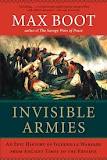
Max Boot is the Jeane J. Kirkpatrick Senior Fellow in National Security Studies at the Council on Foreign Relations. He is a regular contributor to the Wall Street Journal, and many other publications, as well as the author of two other books on war: The Savage Wars of Peace and War Made New. He lives in New York City.
This story, of guerrilla and terrorist warfare, is really one of how “unconventional” warfare has spanned over thirty centuries. The author, an established military historian, traces the practice of guerrilla warfare and terrorism right down to the present decade. He challenges, successfully it seems to me, the conventional wisdom that irregular warfare is the historical exception. Loosely organized guerrilla warfare is actually the norm while the clash of traditional armed forces is the real exception. This alone was a simple insight I gained from reading Boot’s convincing and well-crafted book.
Take the examples that we find in the ancient world, where insurgencies ranged from Alexander the Great to those waged by and against Imperial Rome, and you will quickly see that guerrilla warfare is much harder to defeat than traditional armies. The first empire in human history, that of Mesopotamia, was brought down by nomadic raiders from the Persian highlands. Then I remembered, as Boot recounted the historical events, that it was really the invading guerrilla attacks of the Huns who finally brought down the great Roman Empire. It is a myth, pure and simple, to think that great empires were most often defeated by greater armies and greater fire power. To be large, prosperous and well-armed does not guarantee long-term peace and safety. Surely there is a lesson here for moderns. As I listen to people argue for a large and growing conventional army I still wonder if these arguments will really hold up in the face of the historical evidence which seems so contrary to these arguments, at least as I understand the evidence.
The modern era reveals the same “old” story. Not only have guerrilla and terrorist campaigns become more sophisticated but they have became even more successful. Indeed, the success of the American revolutionaries was due to militiamen called the “American hornets.” I wondered, as I read, “How many Americans actually know that our nation was founded because of a small group of armed citizens who became ‘an unseen enemy’ to the great and overpowering armies of Britain?” These “hornets” struck and then disappeared into the woods. And they pioneered the modern use of propaganda in order to win a much bigger war. Simply put, the very strategies that Americans perfected were to later be used to fight against them in wars in the twentieth and twenty-first centuries.
Terrorist campaigns have been waged in Belle Èpoque Paris, tsarist Russia, and the Reconstruction South following the Civil War. In fact, the white supremacy movement resisted integration and black citizenship in the South for almost one hundred years by using what amounted to terrorist tactics widely accepted or overlooked in the South! So much for thinking of Jim Crowe laws as a rather tame form of civil control.
The twentieth century brought this type of unconventional warfare to a new level. Guerrillas were transformed into heroes and superhuman figures that became mythic. Warfare, for both insurgents and their enemies, would never be the same. One of the most successful guerrilla warriors of our lifetime was Vietnam’s General Vo Nguyen Giap. The war in south Asia was essentially lost because we did not know how to defeat a general like Giap or how to understand a mind that functioned strategically in the way his mind worked. Giap not only defeated the French but then took on the world’s greatest military power and eventually drove us from Indochina. What worked in many of these instances was his ability to harness public opinion so that these conflicts were defined in a way that best suited the plans of the protagonists.
This massive volume is divided into several “Books.” Book I looks at the origins of guerrilla warfare while Book II looks at the rise of liberal revolutionaries, which includes the aforementioned “American hornets.” Book III covers the wars of empire and Book IV is titled: “The Bomb Throwers.” It addresses the rise and development of international terrorism. Book V covers the guerrillas and commandos who worked in and around the major battles of World War I and II. Book VI covers the wars of “national liberation,” which includes leaders like Mao Zedong and his amazing rise to power in China (1921-49) and the Afghan War of Independence (1954-62). Book VII is called “The Romance of the Leftist Revolutionaries.” Here we see the tactics of Castro, Arafat and the end of Marxism in the 1980s. Book VIII is the part that most of us are interested in at the moment because we are living in this time in the history of war. This book is titled: “God’s Killer’s: The Rise of Radical Islam.” More on this section, and what it all actually means to us,in tomorrow’s blog. In this case a little more knowledge of our enemies would help all of us to better understand what works, and does not work, in the so-called “War on Terror.”(I hope our leaders read this book!) A little hint–no terminology for war is more flawed than this: “The War on Terror.” It reveals a basic misunderstanding of terror from the outset. One has a hard time referring to a war on terror in any meaningful sense once you understand what terrorism really is historically.
Related Posts
Comments
My Latest Book!

Use Promo code UNITY for 40% discount!





